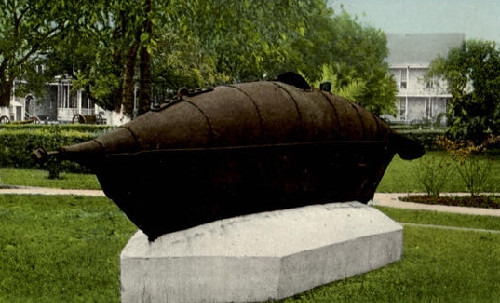| Fort San Juan del Bayou Photos and History of the "Old Spanish Fort" Bayou St. John at Lake Pontchartrain New Orleans, Louisiana |
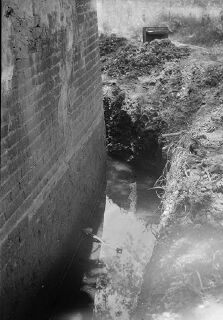
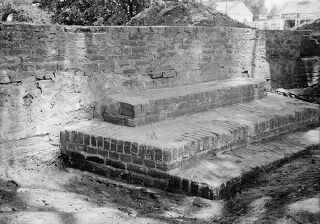
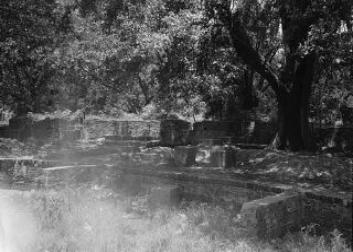
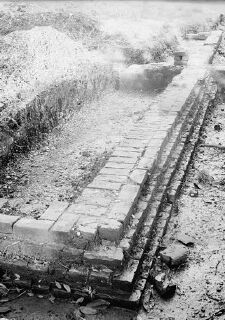
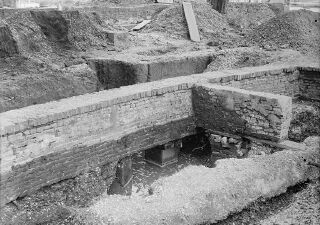
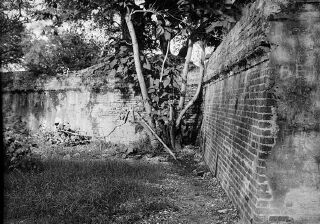
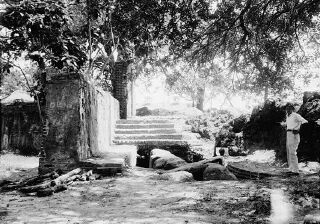
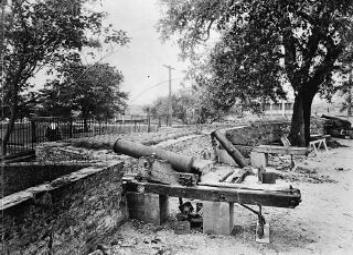
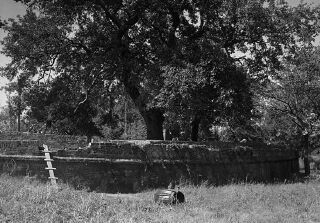
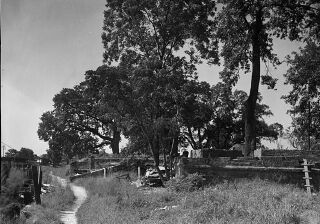
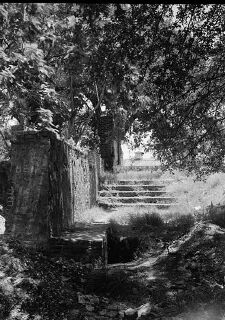

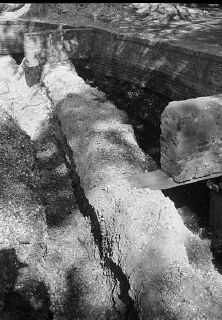
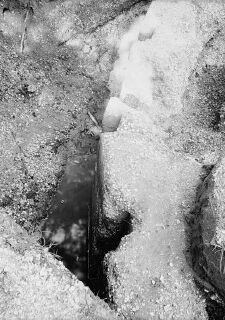
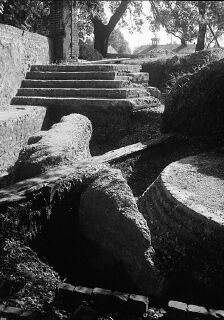
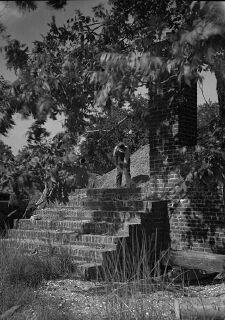
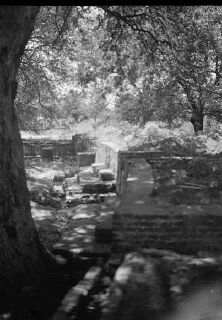
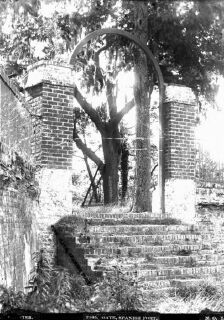
| Much of the fort was already falling into ruin when these pictures were taken in 1934. |
| Inside the fort, looking toward the bayou. |
| View of the fort from the Bayou St. John. |
| Front wall of battlement. |
Lower wall Original palisade
| Front wall. |
| Lower wall of original fort. |
| This photo shows three periods of construction. |
| Top of battlements. |
| Stairs of original hotel built in 1823, after the fort was no longer in use. |
| National Historic Survey Report Old Spanish Fort Resort & Amusement Park The "Little Fort" & Sunny Schiro's Efforts to Save It Spanish Fort Today Back to Old New Orleans Whispers - Home |
Today, Bayou St. John flows languidly through the heart of New Orleans, a favorite place for people to jog, fish or
use the shade of the trees along its banks to wax their cars on sunny summer days.
But, for many decades after the bayou was discovered by French explorers, Bienville and Iberville, it was the vital
means of transportation between Lake Pontchartrain (with its access to the Gulf of Mexico) and the Mississippi
River.
It's not surprising that the first fortification the French established in the area was at the mouth of Bayou St. John,
where it flowed into the lake, probably constructed in about 1701. The fort was originally called Fort St. John of
the Bayou or Fort San Juan del Bayou, later shortened to St. John Fort and, eventually, it became known to New
Orleans residents simply as Old Spanish Fort. The last name remains in use today, more than 180 years after
the fort itself was decommissioned and after its use as a hotel, a fashionable resort and an amusement park. The
park closed its gates in 1926 and the fort has been abandoned since then, allowing nature to re-claim much of its
own and reduce the structures to crumbling ruins.
We're fortunate to have the photographs and data collected during the National Historic Survey, conducted in the
1930's. The photographs on this page are from the NHS report. There are eleven pages in the report, to see
images of the rest, as well as a sketch showing the original location of the Old Spanish Fort, click on the link
directly below the following excerpt from page one. To continue reading my history of the fort, go to the bottom of
this page. To read about the fort as a resort area and see pictures of it as it is today, click on "Old Spanish Fort
Resort and Amusement Park." -- Nancy
"[The first fort] was probably nothing more than a wood palisade, of which all traces have disappeared. When
Spain took possession of the Colony, this fortification was strengthened. There still exist traces of a shell
concrete foundation which supported a wood palisade. No documents of the French and Spanish period have
been found describing this fort, although there are, in the Papeles Procedentes de Cuba in the Archive General
da Indias in Seville, letters referring to the forts and a letter in 1799 containing instructions to the Commandant of
San Juan del Bayou, by which name the fort was known."
Click here to see images of the rest of the NHS report.
use the shade of the trees along its banks to wax their cars on sunny summer days.
But, for many decades after the bayou was discovered by French explorers, Bienville and Iberville, it was the vital
means of transportation between Lake Pontchartrain (with its access to the Gulf of Mexico) and the Mississippi
River.
It's not surprising that the first fortification the French established in the area was at the mouth of Bayou St. John,
where it flowed into the lake, probably constructed in about 1701. The fort was originally called Fort St. John of
the Bayou or Fort San Juan del Bayou, later shortened to St. John Fort and, eventually, it became known to New
Orleans residents simply as Old Spanish Fort. The last name remains in use today, more than 180 years after
the fort itself was decommissioned and after its use as a hotel, a fashionable resort and an amusement park. The
park closed its gates in 1926 and the fort has been abandoned since then, allowing nature to re-claim much of its
own and reduce the structures to crumbling ruins.
We're fortunate to have the photographs and data collected during the National Historic Survey, conducted in the
1930's. The photographs on this page are from the NHS report. There are eleven pages in the report, to see
images of the rest, as well as a sketch showing the original location of the Old Spanish Fort, click on the link
directly below the following excerpt from page one. To continue reading my history of the fort, go to the bottom of
this page. To read about the fort as a resort area and see pictures of it as it is today, click on "Old Spanish Fort
Resort and Amusement Park." -- Nancy
"[The first fort] was probably nothing more than a wood palisade, of which all traces have disappeared. When
Spain took possession of the Colony, this fortification was strengthened. There still exist traces of a shell
concrete foundation which supported a wood palisade. No documents of the French and Spanish period have
been found describing this fort, although there are, in the Papeles Procedentes de Cuba in the Archive General
da Indias in Seville, letters referring to the forts and a letter in 1799 containing instructions to the Commandant of
San Juan del Bayou, by which name the fort was known."
Click here to see images of the rest of the NHS report.
| A visitor to the site wrote to say that the Fort's first commander was Louis Juchereau de St-Denis, uncle by marriage of d'Iberville, also, second cousin to d'Iberville and his brother, Bienville. Later, St-Denis commanded at Post St-Jean Baptiste des Natchitoches. |
In 1763, the Spanish government took control of the New Orleans area and, in the 1770's, the fort was
considerably strengthened by Baron de Carondelet, who later became Governor of the Province.
Since the Spanish were not popular with the many French residents of the area, some jokingly said
that, instead of fortifying the site to protect the residents from outside invasion, they were fortifying
it to protect themselves from the residents.
Years later, the French flag flew over the region once again, but only for a very brief period before
the Louisiana Purchase took place and New Orleans became part of the United States.
During the War of 1812, in an attempt to prevent the British from reaching the city by way of Bayou St.
John, the fort was garrisoned by Major Plauche's Battalion. A volunteer company of light artillery
under the command of Lt. Wagner, also, occupied the fort. But, the British took a different route and
met their defeat south of New Orleans, in Chalmette.
When Congress first allowed the sale of obsolete military sites in 1823, Spanish Fort was sold to
Harvey Elkins, who built a hotel there. There's some argument as to whether it was called the Bayou
St. John Hotel or the Pontchartrain Hotel, but it became a popular place for New Orleanians to get
away from the city and catch the lake breezes during the summer months. This was, in fact, the first
resort to open in the region. Eventually, it was purchased by John Slidell, who renamed it the
Spanish Fort Hotel.
According to an article in the journal of the Louisiana Historical Society, the first torpedo boat
[submarine] ever built was constructed at Spanish Fort on the banks of Bayou St. John, where "...it
was made by Captain Hunley and two soldiers...in 1861-62...in a test, it sunk at the mouth of Bayou St.
John, three sailors losing their lives. The same parties erected another torpedo boat at Charleston, SC,
which, after making a couple of successful attacks against Federal gunboats, sank one day. The one at
Spanish Fort [after being displayed from 1880-1908 at the fort's resort] was eventually given to the
Soldiers' Home and now rests in the Louisiana State Museum, identified as the 'Pioneer.' " See photo
below. -- Nancy
Continued on the "Old Spanish Fort Resort and Amusement Park" page, which contains photos of the
old amusement park; and of the fort as it looks today.
considerably strengthened by Baron de Carondelet, who later became Governor of the Province.
Since the Spanish were not popular with the many French residents of the area, some jokingly said
that, instead of fortifying the site to protect the residents from outside invasion, they were fortifying
it to protect themselves from the residents.
Years later, the French flag flew over the region once again, but only for a very brief period before
the Louisiana Purchase took place and New Orleans became part of the United States.
During the War of 1812, in an attempt to prevent the British from reaching the city by way of Bayou St.
John, the fort was garrisoned by Major Plauche's Battalion. A volunteer company of light artillery
under the command of Lt. Wagner, also, occupied the fort. But, the British took a different route and
met their defeat south of New Orleans, in Chalmette.
When Congress first allowed the sale of obsolete military sites in 1823, Spanish Fort was sold to
Harvey Elkins, who built a hotel there. There's some argument as to whether it was called the Bayou
St. John Hotel or the Pontchartrain Hotel, but it became a popular place for New Orleanians to get
away from the city and catch the lake breezes during the summer months. This was, in fact, the first
resort to open in the region. Eventually, it was purchased by John Slidell, who renamed it the
Spanish Fort Hotel.
According to an article in the journal of the Louisiana Historical Society, the first torpedo boat
[submarine] ever built was constructed at Spanish Fort on the banks of Bayou St. John, where "...it
was made by Captain Hunley and two soldiers...in 1861-62...in a test, it sunk at the mouth of Bayou St.
John, three sailors losing their lives. The same parties erected another torpedo boat at Charleston, SC,
which, after making a couple of successful attacks against Federal gunboats, sank one day. The one at
Spanish Fort [after being displayed from 1880-1908 at the fort's resort] was eventually given to the
Soldiers' Home and now rests in the Louisiana State Museum, identified as the 'Pioneer.' " See photo
below. -- Nancy
Continued on the "Old Spanish Fort Resort and Amusement Park" page, which contains photos of the
old amusement park; and of the fort as it looks today.
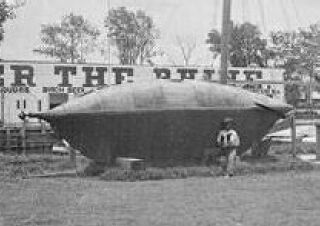
| Above & below, Captain Hunley's first submarine. |
